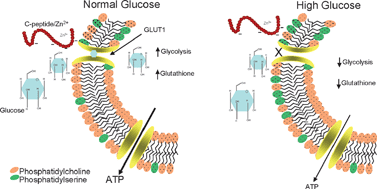Insulin resistance can broadly be defined as the diminished ability of cells to respond to the action of insulin in transporting glucose from the bloodstream into cells and tissues. Here, we report that erythrocytes (ERYs) obtained from type 2 diabetic rats display an apparent resistance to Zn2+-activated C-peptide. Thus, the aims of this study were to demonstrate that Zn2+-activated C-peptide exerts potentially beneficial effects on healthy ERYs and that these same effects on type 2 diabetic ERYs are enhanced in the presence of metformin. Incubation of ERYs (obtained from type 2 diabetic BBZDR/Wor-rats) with Zn2+-activated C-peptide followed by chemiluminescence measurements of ATP resulted in a 31.2 ± 4.0% increase in ATP release from these ERYs compared to a 78.4 ± 4.9% increase from control ERYs. Glucose accumulation in diabetic ERYs, measured by scintillation counting of 14C-labeled glucose, increased by 35.8 ± 1.3% in the presence of the Zn2+-activated C-peptide, a value significantly lower than results obtained from control ERYs (64.3 ± 5.1%). When Zn2+-activated C-peptide was exogenously added to diabetic ERYs, immunoassays revealed a 32.5 ± 8.2% increase in C-peptide absorbance compared to a 64.4 ± 10.3% increase in control ERYs. Phosphatidylserine (PS) externalization and metformin sensitization of Zn2+-activated C-peptide were examined spectrofluorometrically by measuring the binding of FITC-labeled annexin to PS. The incubation of diabetic ERYs with metformin prior to the addition of Zn2+-activated C-peptide resulted in values that were statistically equivalent to those of controls. Summarily, data obtained here demonstrate an apparent resistance to Zn2+-activated C-peptide by the ERY that is corrected by metformin.

You have access to this article
 Please wait while we load your content...
Something went wrong. Try again?
Please wait while we load your content...
Something went wrong. Try again?


 Please wait while we load your content...
Please wait while we load your content...